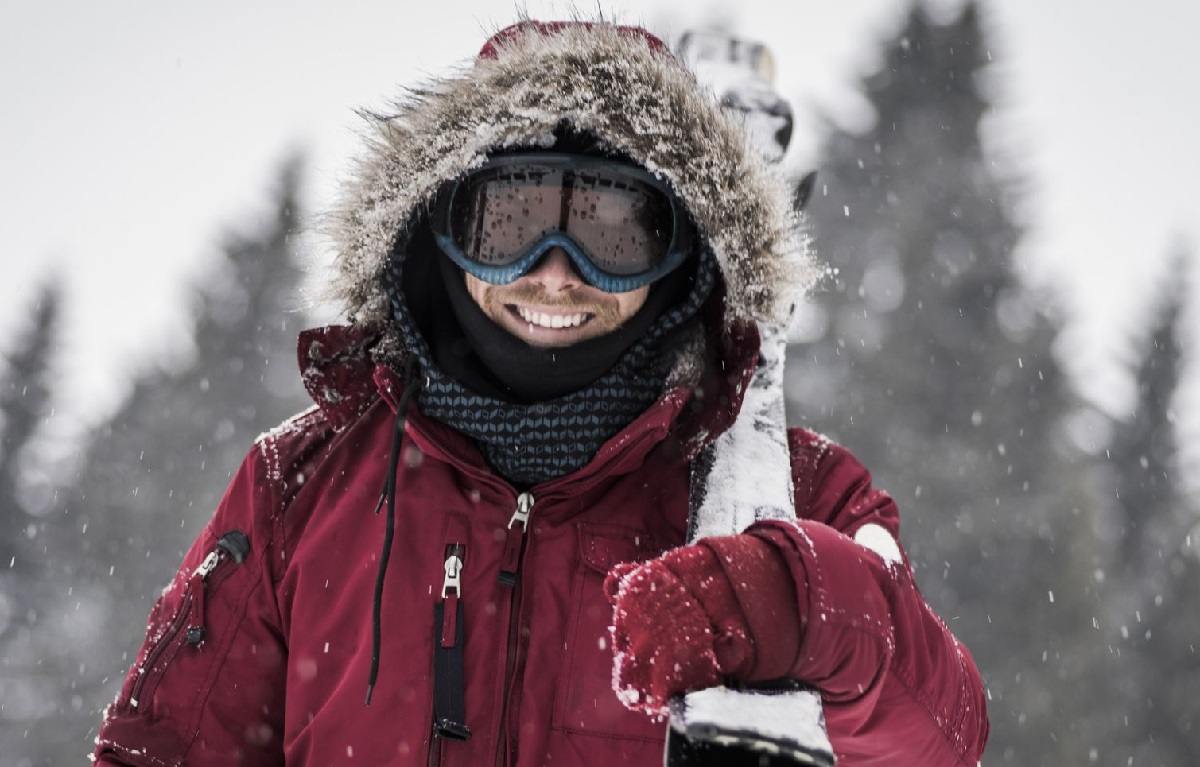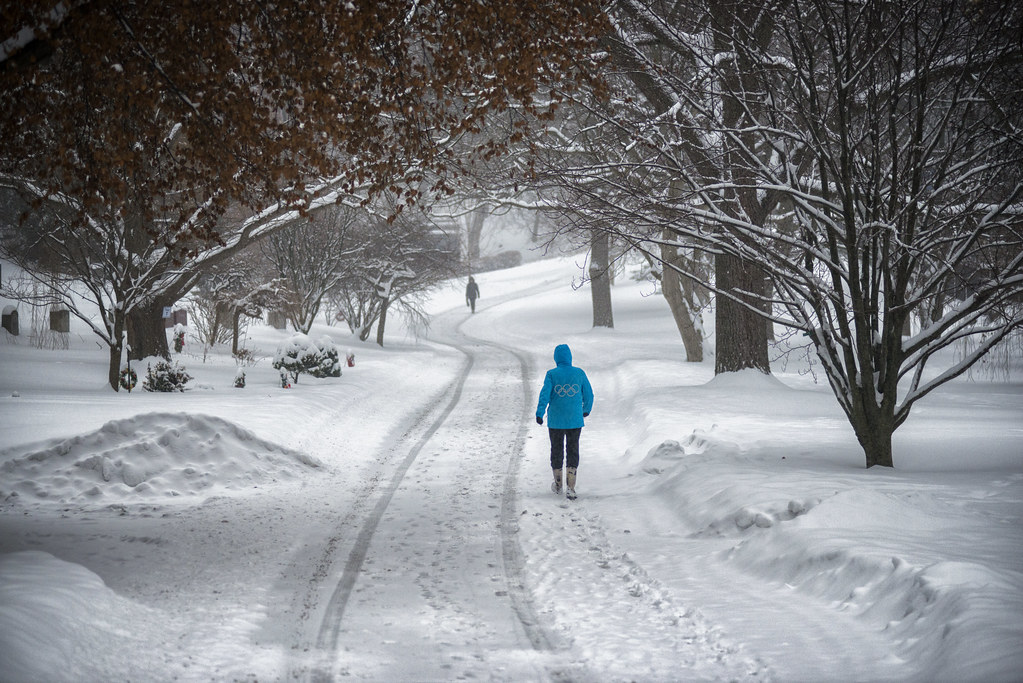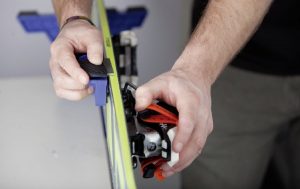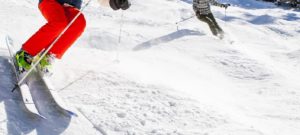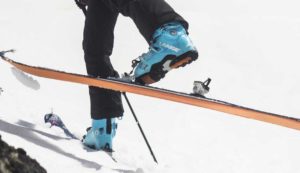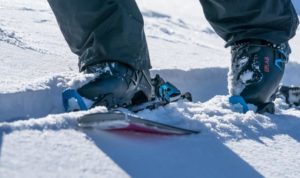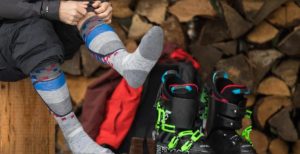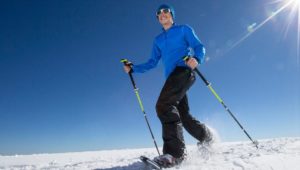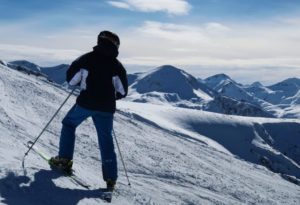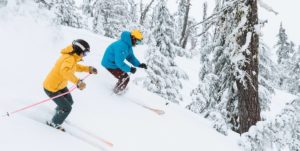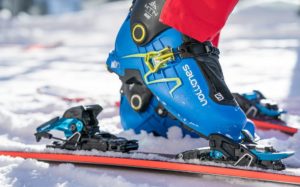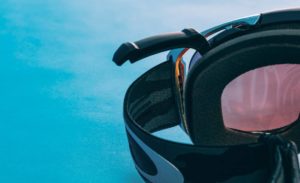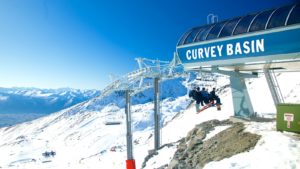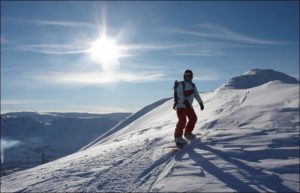Ski jackets are like snowflakes, each one different from the next. To find the best, we researched 70 options, picking 10 top performers to test ourselves. Both in the backcountry and at the resort, our testers skied in rain, puking snow, and bluebird conditions.
We weighed in on each model’s warmth, making sure they could keep us protected while allowing for ventilation on bell-to-bell days and keeping track of the details that added to our experience and those that detracted. Compiling all of this, we’ve selected the best of the best from a dauntingly large selection, and our experts have the info you need to pick a ski jacket tailored to your needs.
Best Overall Men’s Ski Jacket: Arc’teryx Macai
- Very warm and well made
- Down insulation with a waterproof shell
- Body-mapped synthetic insulation in key areas
- Expensive
- Stains easily
- Poor function of velcro on sleeves
After a review of the current market, the Arc’teryx Macai jacket still earns our top spot as the Editors’ Choice winner.
The Macai did not score at the top of any single metric. Instead, rather than offering high marks in a niche area, the Macai is a solid performer across the board, and its insulation durability tips the balance solidly in its favor.
Best Value: Columbia Whirlibird Interchange 3-in-1
- Very warm
- Modular design
- Understated style
- Bulky feeling
- Limited wind and water protection
Right off the bat, it was clear that our Best Buy choice would go to one of the 3-in-1 style jackets. Each jacket tested in that style is priced near the low end of our selection and provides unmatched versatility. This style of jacket, regardless of the brand and model, offers a burly shell and separate, stand-alone insulating liner. This allows you to use the whole package together for maximum protection, use just the shell for warmer conditions, or use the liner on its own around town or during spring skiing weather. While the Patagonia 3-in-1 Snowshot is more polished and offers slightly better weatherproofing than the award winner, the Columbia Whirlibird Interchange 3-in-1 is much warmer and costs half of what the Patagonia model does. Additionally, the jacket is available in Bog and Tall options, so you can fully tailor the fit.
Top Pick for Synthetic Insulation: Spyder Leader
- Stylish
- Loose fitting
- Fast-drying synthetic insulation
- Synthetic insulation not terribly durable
Our Top Pick in this test is an unlikely standout. The Spyder Leader only really wowed our testers with its style and loose comfort. In these categories, the Leader is unequaled. Elsewhere in the test and not unlike our Editors’ Choice, the Leader delivered consistent results. The true value of the Spyder comes in its purpose-built design. This is a fully insulated, high-end, synthetic shell jacket. From other companies, the synthetic jackets in their lineups play “second fiddle” to a top-of-the-line down insulated model. For the synthetic jacket, other companies “dumb down” all the attributes of the jacket. With the Leader, Spyder keeps everything top-of-the-line but insulates with synthetic insulation. In this way, for those users particularly prone to wetness in their ski jacket, the Leader is our Top Pick. If you sweat a lot, or ski hard, day after day, in super wet climates like coastal Washington and BC or the Northeastern USA, but need a top end jacket, check out the Spyder Leader.
Top Pick Shell-Only Jacket: Norrona Lofoten Gore-Tex Pro Shell
- Drum-tight weather protection
- Few pockets
- Durability issues
We have reviewed ski jackets for many years now. For most of that time, we confined our initial selection to insulated jackets. While we still hold that an insulated jacket is the most appropriate for most ski resort use, we also acknowledge that there exist those skiers and riders that wish to build themselves a layering system from individual, purpose-built components. For those users, your upper body protection starts with a shell jacket. The shell keeps off snow, rain, and wind. It needs to be loose-fitting, but with effective seals at the waist, wrists, and head/face. In our years of testing, no product has so effectively sealed out the weather as the Norrona Lofoten Gore-Tex Pro Shell jacket. It is the only shell jacket we tested that incorporates interior wrist gaiters, it has a huge, adjustable hood, and it has the absolute best waist seal of any coat we have tested. When paired with the matching Norrona Lofoten Gore-Tex Pro Pants, which we also tested, the Lofoten’s powder skirt can be cinched, snapped, or zipped to close out the weather. In the zipped-together configuration, the Lofoten pair essentially becomes a one-piece suit, with absolutely no gaps for snow or wind to get in.
Choosing the Best Jacket For Your Needs
Wading through the diverse field of ski outerwear can be a trying task. Fear not, as we have selected 10 of the best ski jackets for this year’s selection. Each piece reviewed is excellent, and every user will find something for them. Our field reflects the entire spectrum, from budget options that work just as well commuting to the office as they do at the ski resort, to purpose-built, high-end offerings that will protect the most discerning riders in the most trying conditions.
Types of Ski Jackets
This review concentrates on ski-specific insulated jackets. Many will also serve other purposes, but their primary function is as ski resort wear. Resort-specific designs are characterized by durable, thick shell fabrics and include (though sometimes removable) insulation.
Modular “3-in-1″Jackets
This style is the most versatile. Like our choice for the best value, the Columbia Whirlibird Interchange 3-in-1, these are for the skier looking for a multi-function, customizable piece on a budget. Each entry in this category is composed of fleece or synthetic insulating liner, and a shell. The two pieces can be worn separately or zipped/snapped together for an easily donned cold-weather jacket. Two primary disadvantages stand out.
In their combined configuration, they are more restrictive and less comfortable than one-piece products of similar warmth. And, for reasons unknown to us, the modular jackets on the market are generally made of slightly lower quality materials. If you want this function with high-end down insulation and the best shell fabrics on the market, you will find a few options. The other 3-in-1 jacket we tested is the Patagonia 3-in-1 Snowshot.
The lining of the three-in-one Patagonia Snow Shot. The light blue seen around the collar is the “reversed” design. Worn the other way the color is lighter and the fabric doesn’t have visible quilting like the side shown here. In any configuration, a three-in-one style jacket is very versatile with broad appeal.
Insulated Shells
The majority of the ski jackets reviewed fall into this category. The amount and type of insulation vary, and the shell fabrics represent a wide spectrum of quality and durability. However, all are purpose-built for riding chairlifts up and skiing down. Price, fit, quality, style, and weather protection vary across the selection. There is something in this category for everyone. The insulated shells tested are the Arc’teryx Macai, the Spyder Leader, Arc’teryx Fission SL, Helly Hansen Alpha, and Patagonia Primo.
Dedicated Shell Jackets
For the first time, we reviewed men’s ski shell jackets alongside the other types. For those wishing to construct their wardrobe from individual pieces, so as to be able to tailor the protection to the user and conditions, that process starts with a ski shell. The ski shell jackets we reviewed are the Norrona Lofoten, the Outdoor Research White Room, and the FlyLow Gear Quantum Pro.
An insulated ski jacket keeps you warm while sitting still on cold lifts.
Criteria for Choosing
We ranked each jacket according to six metrics: Warmth, Weather Resistance, Comfort, Ventilation, Style, and Features.
Warmth
The Columbia Whirlibird is the warmest jacket tested. Next, the Helly Hansen Alpha 2.0, Arc’teryx Macai, Patagonia Snowshot, and Spyder Leader had high insulating values virtually indistinguishable from one another. Due to its loose, drafty fit, the latest iteration of the Patagonia Primo is tied with the much lighter Arc’teryx Fission SL for lesser insulation. The shell jackets all had far less insulation value, with only the Outdoor Research White Room edging slightly ahead due to its thin fleece lining.
The Helly Hansen Alpha 2.0 is a warmly insulated, weather-sheltered jacket for all-around ski resort use. Warmth is a function of insulation type, amount, and the draft-sealing attributes of the piece of clothing.
Weather Resistance
Weather resistance is a function of three things, in declining order of importance: construction, waterproof materials, and the durable water repellent coating (DWR). For routine resort use, construction and design will influence the degree of wind and precipitation protection. The jacket needs to be constructed from waterproof and breathable fabrics and coated with an effective DWR.
However, design and construction, particularly with regard to seam integrity, hood shape, waist sealing, and wrist cuff style, are by far the biggest determinants of weather resistance. The most weather-resistant coats tested are constructed well, regardless of the fabric technology used. That said, good fabrics sewn well trump poor fabrics sewn in the same way. Finally, to be clear, we discuss mainly water resistance in our reviews. However, because anything that resists water will resist wind and snow as well, we can extrapolate overall weather protection from tests, and discussion of water resistance.
Manufacturers and sales personnel make a big deal of the technology in the shell fabrics. Gore-Tex, a well-established brand manufacturing raw materials and licensing its use to many clothing companies, describes its fabrics and company-certified garments as “Guaranteed to Keep You Dry.” This implies both protection from solid and liquid water, and transmission of body-generated water vapor. In our review, the Patagonia Primo Down, Arc’terx Macai, Arc’teryx Fission, and Norrona Lofoten Gore-Tex Pro Shell are made of Gore-Tex. Other manufacturers use a pair of five-digit numbers to describe both waterproofness and breathability (“10,000/10,000”, or further abbreviated to “10k/10k”).
The first number in the pair describes waterproofing by indicating the number of millimetres of water the fabric can withstand over a 24-hour period. That is in perfect condition. The second number describes breathability, in grams of water vapor that can pass through a square meter of fabric in a 24-hour period. What does all that mean in real life? First of all, these numbers and claims are assigned by the manufacturer. Little to no independent testing is performed. Second, basically, all fabrics available (certainly all in our tests) are good to the claimed 10k/10k performance. And that is plenty. All this is interesting academic information, but we can move on now, as all the jackets reviewed are made of high performing fabrics.
Each company does it differently, but at some point in the process, the manufacturer coats the outside of the fabric with a DWR. This is what makes water bead up on the garment. The above-described waterproof/breathable laminates are inside of the shell fabric. In order to keep the outer fabric dry (and breathable — soaked fabric does not breathe) it is treated with DWR. In usage, the DWR is often the least durable part of the entire jacket and wears off over time.
We reviewed the DWRs in our sprinkler test. While soaking the fabric, simulating rain, wet snow or both, we rubbed the forearm of everyone. This simulates actual usage. Arms rub against the body, bodies rub against the snow, chair lifts rub against backs and shoulders. Patagonia garments, the Patagonia Primo and Patagonia 3-in-1 Snowshot have the best DWRs in our test. The Arc’teryx products come next, with the soft outer fabric of the Helly Hansen Alpha delivering an impressive performance. The Spyder Leader eventually wet out in this test. In each case, however, the truly waterproof part is protected and hidden by the shell fabric. The DWR on the Norrona Lofoten Gore Tex Pro Shell was the best, with the OR and FlyLow products faring well.
The hood of the Spyder isn’t the best in our test. It is uninsulated (while the rest of the jacket has pretty good insulation) and the forehead coverage is less than that on something like the Arc’teryx Macai.
Again, and we cannot say this enough, the design is far more important. All the ski jackets in our review are made of waterproof/breathable fabric. Weather resistance performance is, therefore, a function of construction and fit, with DWR playing a role as well. We looked for thoughtfully designed hoods, high, stiff collars, effective cuffs (with inner, secondary cuffs a bonus), protected zippers, and long sleeves and hems. Our top scorers were both Arc’teryx models and the Patagonia Primo Down. The Norrona Lofoten Gore-Tex Pro Shell tops the shell jacket field with immaculate cuffs, a huge hood that can be cinched down, and a powder skirt that can be attached to the matching pants to form a one-piece suit. In insulated jackets, weather resistance and warmth often come from the same features. Jackets that came out on top in overall scores were also the ones that performed best in weather resistance and warmth.
Ventilation
The Columbia Whirlibird and Patagonia Snowshot offer modular, “3-in-1” designs that are well suited to ventilation and adaptation They earned our highest scores for ventilation.
Mesh backing of the pit-zips prevents air from flowing inside the jacket freely, though the mesh does keep snow out.
The Outdoor Research White Room has long zipped starting on the chest with no mesh backing. It is the best non-3-in-1 venting jacket reviewed. Among the insulated jackets, none have all the vent attributes we look for.
The Spyder Leader has mid-length zips that start on the chest but are backed with mesh. In comparing these jackets and their different venting styles head to head, the Spyder is slightly more effective. This suggests to our team that the location of the vents has a greater impact than the removal of the mesh backing. The Norrona Lofoten Gore Tex Pro Shell and FlyLow Gear Quantum vent well, while the remaining insulated jackets (Helly Hansen, Arc’teryx Macai) have nothing notable in terms of ventilation.
The chest-to-armpit zips of the Spyder Leader pull air in better than pit-only zips. Despite their mesh coverage and relatively short length, these are some of the more effective vents in our review.
Ski Features
A handful of niceties augments a well-designed jacket. Throughout our review, we looked for plentiful pockets, ski pass clips and pockets, integrated goggle wipes, and systems to join jackets and pants into an integrated package.
The top scoring jackets in this category were the Helly Hansen Alpha and the Spyder Leader, which both came loaded with conveniences. Of the shell jackets, the Outdoor Research White Room has the most features, while the Norrona Lofoten Gore Tex Pro Shell has the fewest. The FlyLow Quantum has a ton of pockets, but few other niceties. The Patagonia jackets are near the middle of the pack. The Arc’teryx Macai has more features than its brother the Arc’teryx Fission SL.
Fit and Comfort
Fit is king. We go to the mountains to feel good. We want to feel good in our clothes. Fit and comfort, like weather resistance, are functions of materials and construction. Carefully constructed garments fit better. However, fit varies from one person to another. Second, only to style, fit and comfort is subjective. What fits one person may or may not fit the next. In order to address this, we tested on a variety of body shapes and in each review we rate overall fit as a single number but elaborate on what was different from one piece to another. It is worth noting that primary testing was done by thin, size medium men.
When we say a jacket like the Patagonia Primo was “boxy and loose”, we mean that everyone will have this same experience, relative to the other jackets tested. A barrel-chested man may appreciate this boxier cut. All the jackets tested were marketed as size medium by their manufacturers. The Helly Hansen Alpha and Spyder Leader earned high scores in fit and comfort, coming to that performance from two very different directions. The Arc’teryx Alpha is constructed with what seems like 15 different soft and flexible fabrics. Virtually every part stretches and hugs the body. Visible bulk mainly comes from the insulation.
The Spyder Leader is looser in fit, with a brilliant collar and sleeve design that virtually disappears on the wearer. We also love the fit of the lightly insulated Arc’teryx Fission SL. The Arc’teryx Macai feels similar to the Helly Hansen – close and cozy – but accomplishes this with careful tailoring instead of the stretchy fabrics of the Alpha. The FlyLow Gear Quantum and Outdoor Research White Room shell jackets are constructed of a stiff material that feels protective but confining. The Norrona Lofoten Gore-Tex Pro Shell is the lightest reviewed, with a thin fabric that moves with you. The Columbia Whirlibird and Patagonia 3-in-1 Snowshot are the most confining and bulky, attributable to the extra layers of fabric involved in their construction.
The Arc’teryx Fission SL swaggers to the backcountry gate, while the Columbia Whirlibird Jacket says “I go to the mountains, but don’t take myself too seriously.” The FlyLow Gear Quantum shell is beefy, with rigid fabric that holds its shape around people of all dimensions.
Accessories
To keep your legs comfortable and warm while hitting the slopes, we recommend the Arc’teryx Sabre and The North Face Freedom Pant. Both of these pants fit well and are weather-resistant. Also notable, if only for its incredible integration with our Top Pick shell jacket, the Norrona Lofoten pants are excellent. For a more in-depth look of all the ski pants we reviewed, check out The Best Ski Pants Review.
Don’t forget about your hands, either. For the most warmth and dexterity, we recommend the Black Diamond Mercury Mitt. Check out The Best Ski Gloves Review for a full look at all the gloves we reviewed.
See also our downhill ski reviews for our Top Picks of Men’s and Women’s skis.
Conclusion
This lightweight, weatherproof, and very warm jacket takes the top score in our ski jacket review. The Arc’teryx Macai is well articulated and has an elegant collection of ski features. We went deep into reviewing the top 10 ski jackets available in hopes of helping you sort through the list.

